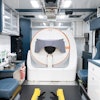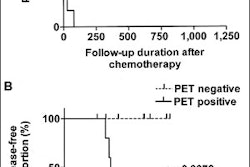There are studies to complete and much work left to do, but virtual colonoscopy is making steady progress toward becoming a tool for widespread colorectal cancer screening, according to Dr. Judy Yee from the University of California, San Francisco. In a talk at the 2003 International Symposium on Multidetector-Row CT, the noted VC researcher offered her views on the state of the procedure.
"Up to 10% of polyps between 10 and 20 mm will be malignant, and when you go over the 20-mm mark, up to 40% will be malignant," she said. "In general it takes up to 10 years for a 10-mm polyp to transition into an invasive carcinoma, so what that means is that colon cancer is a malignancy that's ideally suited to screening. There's a huge window of opportunity where we can go in and detect and resect precursor lesions."
Finding colon cancer requires screening, of course. Current recommendations include the fecal occult blood test (FOBT) combined with flexible sigmoidoscopy every five years, or a double-contrast barium enema every 5 years, or the gold standard, conventional colonoscopy, every 10 years.
Conventional colonoscopy is the gold standard for good reason, Yee said. It has high sensitivity and specificity -- up to 94% sensitivity for the lesions 10 mm and larger that are considered clinically significant. But the literature also shows that the procedure misses its share of polyps, including more than a quarter of those 5 mm and smaller.
Moreover, colonoscopy is invasive and time-consuming, often requires sedation, and has a highly variable compliance rate. Then there is the risk of perforation: 1 in 1,000 without polypectomy and 1 in 500 with polypectomy. There is bleeding in 3 in 1,000 patients, and even 1-3 deaths in every 10,000, Yee said. Ten percent of colonoscopies are incomplete, i.e., fail to reach the cecum.
And although the goal is to screen every American 50 and older for colorectal cancer, there are 74 million people of screening age while only 4.4 million colonoscopies were performed in the U.S. last year.
"I hope I've convinced you that there's a need for another colon screening exam, and I believe that CT colonography (CTC) or virtual colonoscopy (VC) is one of the answers," Yee said.
Technique
A clean, well-distended colon is essential for obtaining diagnostic exams, she said. For cleansing, saline cathartics such as magnesium citrate and sodium phosphate preparations leave the colon drier than polyethylene glycol, Yee said, and therefore result in scans that are easier to interpret. For colon insufflation prior to CT, manually administered room air has been the traditional choice, but Yee said she gets better, more consistent distension using electronic CO2 insufflation.
The radiologist should always scan in both prone and supine positions, and use thin collimation settings, which for the new 16-slice scanners means 1 to 1.25 mm. Subsecond scanning, mAs < 100, and reconstructions with at least 50% overlap are needed to maintain sensitivity.
"What's key is to synchronize the axials in the supine and prone positions, and to use this as your primary method of interpretation," she said. "For problem-solving I would then go to my coronal or sagittal MPRs, and if that doesn't settle the issue I'll go to my 3-D endoluminal images. What's offered on various vendor platforms is either the fly-through, actual real-time viewing, or you can create subvolume cube views which are quite useful and fairly quick."
Three of the largest virtual colonoscopy studies to date have found per-polyp sensitivity of about 90% for the detection of lesions 10 mm and larger, with a fourth study weighing in at 75%, she said. For lesions 5-9 mm, sensitivity drops to about 80% for the three studies, and VC's sensitivity is poor across the board for polyps 5 mm and smaller. Yet the procedure has shown excellent results for the detection of cancer, with sensitivity from 96% to 100% in the three major studies, and 82% in the fourth.
The sensitivity was 94% (64 of 68) for the detection of adenomas 10 mm or larger, 82% (72 of 88) for adenomas 5.0-9.9 mm, and 66.9% (95 of 142) for adenomas smaller than 5 mm. CT colonography was used to identify all eight carcinomas. According to the conclusion, CT colonography has excellent sensitivity for the detection of clinically important colorectal polyps and cancer.
Among these papers, Yee and colleagues' own virtual colonoscopy study in 300 patients, one-third asymptomatic and two-thirds at high risk, yielded per-polyp sensitivities of 90% for the detection of polyps 10 mm and larger, 80.1% for polyps 5.0 to 9.9 mm, and 59.1% for polyps smaller than 5 mm, compared to conventional colonoscopy. VC identified all eight carcinomas (Radiology, June 2001, Vol. 219:3, pp. 685-692).
Per-polyp assessment, which matches both the lesion's size and location to colonoscopy, is a more rigorous test of accuracy than per-patient assessment. However, some would argue that the less-rigorous per-patient matching scheme is more clinically relevant, since high per-patient sensitivity means that 100% of patients with clinically significant polyps on VC are referred for conventional colonoscopy, regardless of the polyp's location, Yee said.
"CT has proven value in the setting of incomplete colonoscopy, and there are four published studies saying that in this situation," she said. "(Virtual colonoscopy) can identify not only additional polyps, but synchronous carcinomas in areas that are not identified by colonoscopy."
Virtual colonoscopy has also shown an ability to detect incidental findings, most frequently masses in all of the solid organs, lung nodules, and abdominal aortic aneurysms. In a study by Hara et al, for example, 11% of patients undergoing virtual colonoscopy had highly significant findings (Radiology, May 2000, Vol. 215:2, pp. 353-357).
In that study, 7% of patients underwent additional imaging, and 2.3% actually underwent surgery because of the incidental findings,Yee said. The added cost was just $28 per patient. Other studies, too, have shown a fairly consistent 8%-11% range for patients with significant extracolonic findings.
"What are the disadvantages of having to deal with all these extracolonic lesions?" Yee said. "Well, if we are obligated to identify extracolonic lesions we cannot use the ultralow dose (as low as 10 mAs in some studies). We have to look for all of these lesions and this significantly increases interpretation time, there's increased patient anxiety, morbidity, mortality, and we wind up looking for and working up (benign) lesions...."
The road ahead
The future is likely to offer more prepless exams, both with and without electronic subtraction of fecal material, for which patients drink a barium sulfate mixture or iodinated oral contrast 1-2 days before CT.
"I am convinced at this point that there will be a subset of patients who benefit from the use of IV contrast," Yee added. She also sees increasing use of electronic CO2 insufflation. Barium sulfate prep may or may not be used with electronic subtraction of fecal materials.
"We have to optimize low-dose technique as we move to more detectors with CT, evaluate new displays such as the virtual dissection view ... and finally we have to integrate computer-aided detection," she said, adding that published CAD studies have shown high sensitivity for the detection of significant polyps, though with fairly consistent false-positive rates of about 8 per patient.
Yee also listed the major multicenter virtual colonoscopy trials:
- In the ACRIN National CT Colonography Trial Part I, for example, virtual colonoscopy yielded about 89% sensitivity for the larger polyps compared to conventional colonoscopy. It is hoped that ACRIN Part II will begin later this year.
- The Charleston-based Medical University of South Carolina (MUSC) trial compared conventional to virtual colonoscopy in a multicenter setting. Final (PDF file) second-year results in 615 subjects pegged VC's sensitivity at just 39% for polyps > 6 mm, and 55% for polyps 10 mm and larger, with specificity of 96%. Still, the study's methodology and lack of quality control have been widely criticized.
- Finally, preliminary results from a multicenter military trial are very promising, Yee said. They show 100% by-polyp sensitivity for polyps 10 mm and larger, 86% sensitivity by patient.
"These are my current indications for performing VC," Yee said. "I perform virtual when there is a contraindication for colonoscopy, when we have a failed colonoscopy, (for) patients who are on anticoagulation therapy, patients who are elderly or frail, and finally, this is a bit controversial, for asymptomatic patients who refuse any other type of screening."
On the to-do list, virtual colonoscopy must still succeed in a large screening population, and radiology standards must be developed for performing and interpreting the exam. And radiologists must come to a consensus on an appropriate polyp cutoff size for reporting and/or referral to conventional colonoscopy.
"Is it 10 mm and above, or should we dial that down to about 7 mm -- and obviously this would affect the screening interval," Yee said, adding that matters of patient preference aren't quite settled either. "I think we need to repeat some of the (patient acceptance) studies with what I call the comfort enhancers, with carbon dioxide (insufflation) and a prepless version." By Eric BarnesAuntMinnie.com staff writer
September 12, 2003
Related Reading
Group favors 3-D primary read in major virtual colonoscopy trial, September 2, 2003
Virtual colonoscopy study results disappointing, August 13, 2003
Virtual colonoscopy techniques evolve with technology, July 25, 2003
Virtual colon dissection is promising, if flawed, July 9, 2003
Multislice CT may improve virtual colonoscopy results, May 2, 2003
Colon CAD finds complementary role with radiologists, April 23, 2003
Copyright © 2003 AuntMinnie.com




















